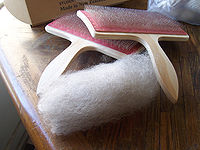
Rolag
Encyclopedia

Spinning (textiles)
Spinning is a major industry. It is part of the textile manufacturing process where three types of fibre are converted into yarn, then fabric, then textiles. The textiles are then fabricated into clothes or other artifacts. There are three industrial processes available to spin yarn, and a...
woollen yarn. A rolag is created by first carding the fibre, using handcards
Carding
Carding is a mechanical process that breaks up locks and unorganised clumps of fibre and then aligns the individual fibres so that they are more or less parallel with each other. The word is derived from the Latin carduus meaning teasel, as dried vegetable teasels were first used to comb the raw wool...
, and then by gently rolling the fibre off the cards. If properly prepared, a rolag will be uniform in width, distributing the fibres evenly.http://thelibrary.springfield.missouri.org/lochist/periodicals/bittersweet/su75f.htm
Animal fibres
Animal fiber
Animal fibers are natural fibers that consist largely of particular proteins. Instances are silk, hair/fur and feathers. The animal fibers used most commonly both in the manufacturing world as well as by the hand spinners are wool from domestic sheep and silk. Also very popular are alpaca fiber...
have traditionally been used to create rolags, but today's spinners use many different fibre materials, including manufactured and plant fibres
Fiber crop
Fiber crops are field crops grown for their fibers, which are traditionally used to make paper, cloth, or rope. The fibers may be chemically modified, like in viscose or cellophane...
.
Resources
- Hoke, Alexa and Terry Brandt. "Through the Wool Cards", Bittersweet Volume II, No. 4, Summer 1975.

